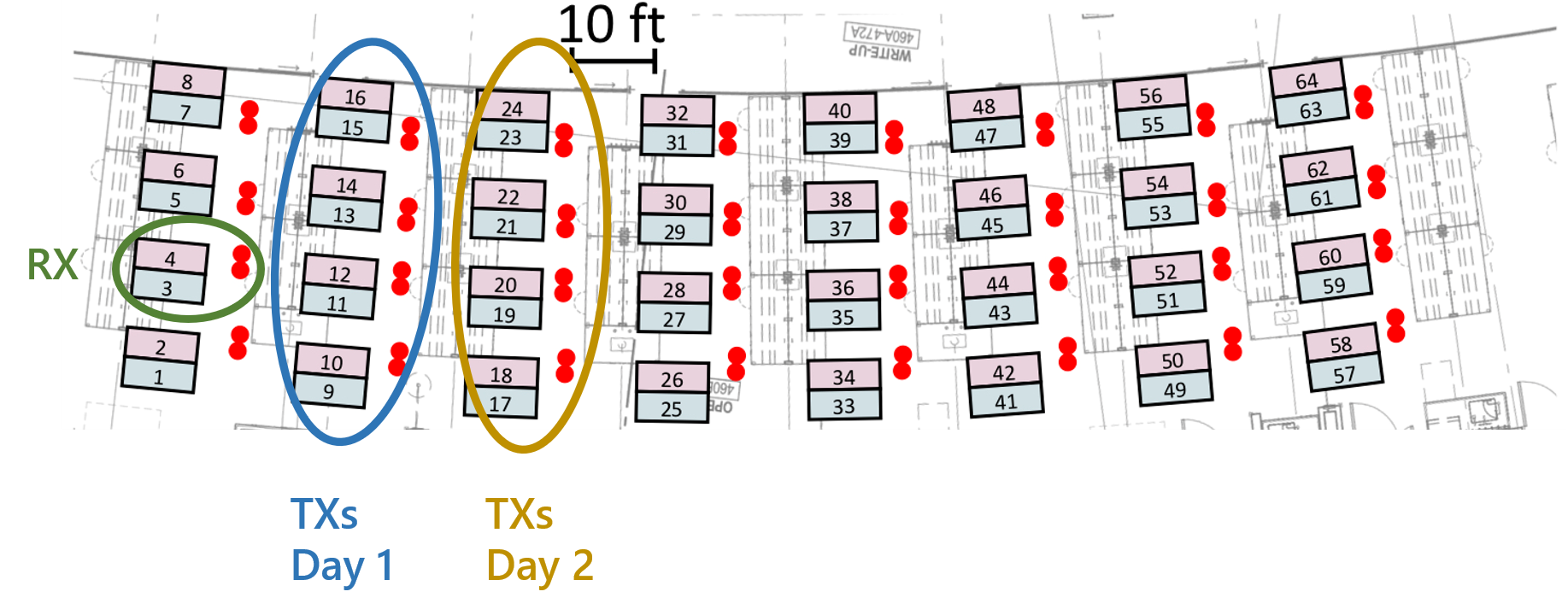Dataset Release: A Real World IEEE 802.11 a/g Dataset and Simulated LTE-M Uplink Dataset for Spectrum Sensing
This repository contains the code and links to the datasets curated and used in D. Uvaydov, S. D’Oro, F. Restuccia and T. Melodia, "DeepSense: Fast Wideband Spectrum Sensing Through Real-Time In-the-Loop Deep Learning," IEEE INFOCOM 2021 - IEEE Conference on Computer Communications, 2021, pp. 1-10, doi: 10.1109/INFOCOM42981.2021.9488764. The paper can be found for free here and cited using the key or citation found at the bottom
Spectrum sharing will be a key technology to tackle spectrum scarcity in the sub-6 GHz bands. To fairly access the shared bandwidth, wireless users will necessarily need to quickly sense large portions of spectrum and opportunistically access unutilized bands. To that end we have developed two datasets to help evaluate spectrum sensing methodolgies: a over the air real-world dataset collected using 5 USRP N210s with 802.11 a/g PHY layer waveforms and a simulated MATLAB dataset with LTE-M uplink PHY layer waveforms. In both datasets, data is in the form of I/Qs or complex values.
This dataset emulates four 5-MHz-wide non-overlapping channels, occupying a total of 20 MHz bandwidth. We collected this dataset using 5 USRP N210s SDRs running GNU Radio. Four USRPs acted as WiFi transmitters, each with 64 sub-carriers, and one as the receiver sampling at 20MS/s to obtain the whole bandwidth. Data was collected from two separate days with two different transmitter orientations to give the dataset diversity in the SNR and channel effects it contained. Layout is shown below.
The dataset contains a 32 .bin files, 16 for the first day and 16 for the second day each of the 16 representing a different combination of bandwidth occupation (i.e. 1101_day2.bin means the first, second, and fourth channels are occupied, collected on the second day). Each of these files contain a complex time series signal which can be read with
import numpy as np
time_series_signal = np.fromfile(filepath, dtype=np.complex64, count=-1, offset=0)Furthermore we have provided two scripts that first converts each .bin to an .h5 file (sdr_wifi_code/bin2hdf5.py) and then generates a training and testing dataset with its corresponding labels in two large .h5 files (sdr_wifi_code/preprocessing.py). This is the same workflow that we follow for our paper before training.
This dataset is created utilizing MATLABs LTE Toolbox to simulate LTE-M uplink transmissions in the Physical Uplink Shared Channel (PUSCH) over a 10-MHz-wide band. We split the spectrum band into 16 non-overlapping sub-bands (3 resource blocks or 540kHz wide), each acting as their own channel allocated to a user. The dataset that we used can be found using the link above but if one were to wish to generate their own they can use sim_lte_code/generateLTEDataset.m. This script takes heavy inspiration from the following MATLAB example which is a highly recommended read to understand the code. The code will generate two .h5 files, one as a training set and another as a test set for a specific SNR and input size to the CNN (i.e. lte_neg10_32_train.h5 is the training data for a channel that experiences different holes with an SNR of -10 dBW and broken down into training samples containing 32 I/Q samples each). Within the .h5 file, whether training or testing, there will be two groups 'X' and 'y' which will contain the I/Q training samples and labels respectively. We have provided our dataset for a 32 I/Q input size at varying SNRs as used in our final network.
We have provided a barebones script to train/test the network in the paper used for the WiFi and LTE datasets found in train_test_CNN.py. Running the code as is will train for the SDR dataset that is generated using the scripts in sdr_wifi_code (first running bin2hdf5.py and then preprocessing.py). To train enter python train_test_CNN.py train into the command line and to test python train_test_CNN.py test.
Daniel Uvaydov: uvaydov.d@northeastern.edu
Salvatore D'Oro: s.doro@northeastern.edu
D. Uvaydov, S. D’Oro, F. Restuccia and T. Melodia, "DeepSense: Fast Wideband Spectrum Sensing Through Real-Time In-the-Loop Deep Learning," IEEE INFOCOM 2021 - IEEE Conference on Computer Communications, 2021, pp. 1-10, doi: 10.1109/INFOCOM42981.2021.9488764.
@inproceedings{uvaydov2021deepsense,
title={Deepsense: Fast wideband spectrum sensing through real-time in-the-loop deep learning},
author={Uvaydov, Daniel and D’Oro, Salvatore and Restuccia, Francesco and Melodia, Tommaso},
booktitle={IEEE INFOCOM 2021-IEEE Conference on Computer Communications},
pages={1--10},
year={2021},
organization={IEEE}
}